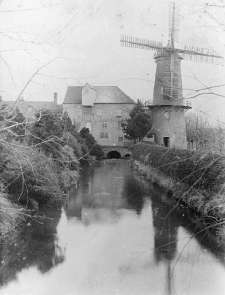 |
|
c.1900
|
|
Burnham Overy Union Mill
River Burn |
 |
|
c.1900
|
|
Burnham Overy Union mill is one of only three mills in Norfolk to use both water and wind power from the same site, the others being Little_Cressingham and Thurning. During parts of the 20th century the mill was sometimes known as Roy's Mill. However, it was more often called the Union Mill because unlike Little_Cressingham and possibly Thurning, the tower windmill on this site was actually linked to the machinery within the watermill ...being completely connected & the floors are parallel to each other... and was capable of driving the stones in both buildings. The watermill section had 3 pairs of stones and the windmill had a further 2 pairs. The windmill could also work the flour mill within the watermill when requird. Both mills were built in 1737, being constructed of brick, the watermill having two storeys under a Norfolk pantiled roof, with a third storey being added later. The windmill was originally built with five floors but a sixth was subsequently added. In 1825 the sails had copper vanes. |
Although the iron undershot Poncelet type waterwheel was still intact in the 1960s, at some point between 1865 and 1896, stone grinding was discontinued and the mill was converted to a roller system. In 1925 the mill was listed as using gas power, the only listing of its type I have seen so far (possibly gas oil as opposed to coal gas). By 1937 the listing had changed to oil. However, in 1953 Sidney Roy wrote to the East Anglian Magazine stating that the waterwheel built by Whitmore & Binyon of Wickham Market was "...still going strong every day grinding and crushing oats, etc" |
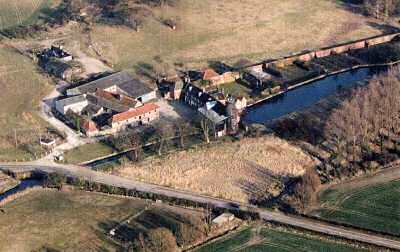 |
|
Aerial
study c.1997
|
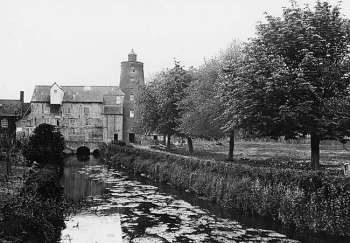 |
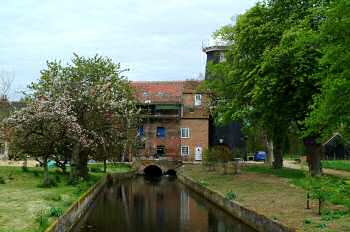 |
|
c.1930
|
3rd
May 2003 |
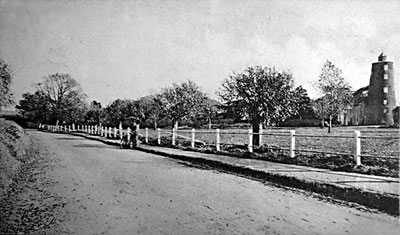 |
1907 |
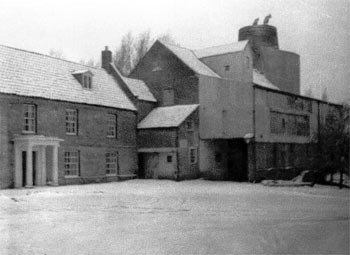 |
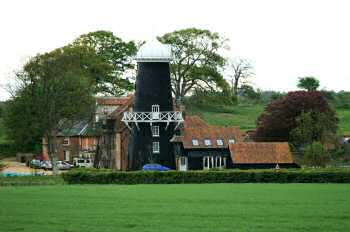 |
|
c.1948
|
3rd May 2003 |
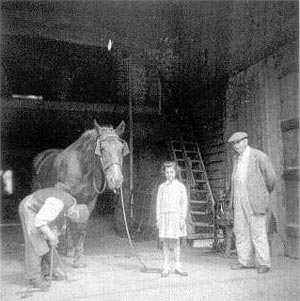 |
Wilfred Ives shoeing a horse watched by Carol Wiliams 1954 |
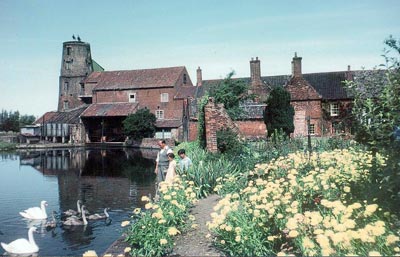 |
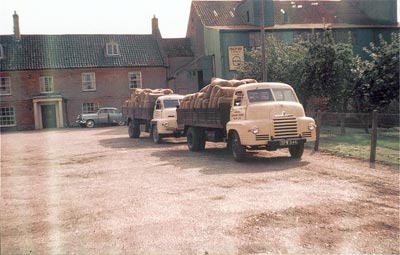 |
Mill dam 1954 |
Mill lorries 1954 |
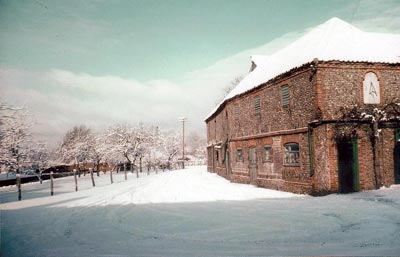 |
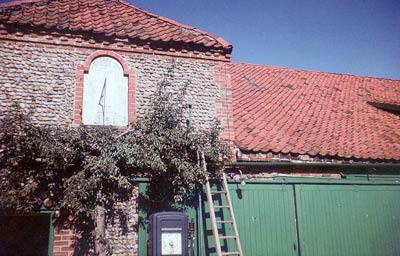 |
Looking towards the road 1954 |
The sundial and petrol pump 1954 |
|
The windmill
sails disappeared during the first half of the 20th century and a windowed
weatherboarded leanto section was built on the front. |
|
A message written in lead pencil was preserved on the roof rafters near the tower: French fleet seen 1798 |
 |
|
Napoleonic
war peace tablet
|
|
Thomas Beeston placed a stone tablet above the doorways on either side of the towermill in 1814 to commemorate the end of the Napoleonic wars and Napoleon's exile to the island of Elba. |
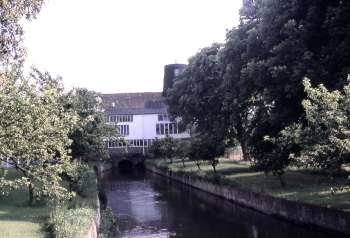 |
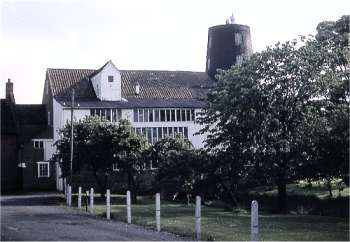 |
|
Tailrace
June 1968
|
June 1968 |
|
Some details
of the working windmill included: |
 |
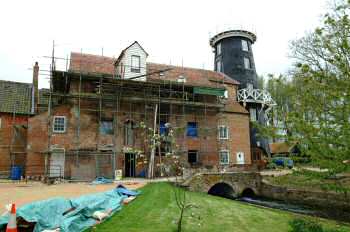 |
|
c.1997
|
Renovation 3rd May 2003 |
|
Delightful Residence, |
|
On Wednesday August 3rd 1825. At the
Norfolk Hotel in Norwich at 3 o'c. In one Lot
|
A most valuable compact ESTATE in the occupation of Mr. Thomas BEESTON,
the proprietor comprising an excellent Family House... A superior WATER
CORN MILL standing on a fine stream, driving three pair of stones, with
store rooms, flour chambers, counting room etc. Adjoining& communicating
with it is a most valuable & substantial TOWER WINDMILL with patent
sails and copper vanes, five floors, arch for waggons unloading corn &
drives two pair of stones. The Mills are called the Union Mills, being completely
connected and the floors are parallel to each other. The Windmill is by
improved machinery rendered capable of working the flour machine in the
water mill when required, by which much manual labour is dispensed with.
The other buildings... large brick & tiled barn with carpenter's shop,
waggon lodges & granary over, a long range of stabling capable of holding
10 or 12 horses, chaise & harness rooms, with an excellent granary or
corn room 96 feet long. At the back of the buildings are two enclosed bullock
yards with sheds, stabling, piggeries & pump house, with walled-in stack
yard. Adjoining the premises is an Inclosure of rich Pasture Land... Adjoining the Mills... Meadow Land... The Premises are in perfect repair, considerable sums of money having been expended to render the Estate what it is universally allowed to be, the most compact & ornamental of its kind in the county of Norfolk. Burnham is distant from the Market Town of Fakenham 10 miles, from Wells & Walsingham 5 miles & from Lynn 20 miles. The Estate is situated in a remarkably good corn country & only one mile distant from the Harbour, which, combined with the powers of the Mills & the present very respectable trade carried on in them, renders the concern an object of peculiar interest to enterprising Capitalists. The Estate may be viewed on application the the Proprietor on the premises & further particulars may be had on applying (personally or by letters post paid) to the Auctioneer, Norwich or to Mr. WATSON at Fakenham. By J. Culley Norfolk Chronicle - 9th, 16th, 23rd & 30th July 1825 |
 |
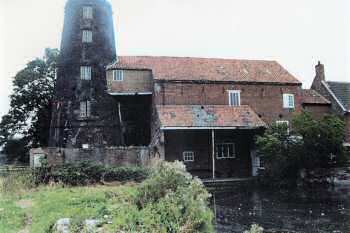 |
|
|
Mill
dam June 1968
|
Mill
dam c.1997 |
|
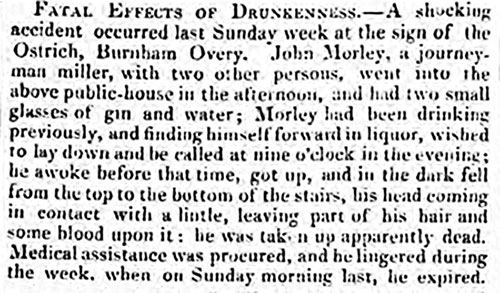 |
|
Bury & Norwich Post - 29th February 1832 |
To Parents & Guardians |
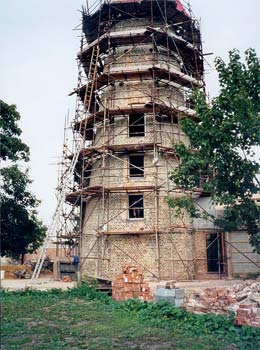 |
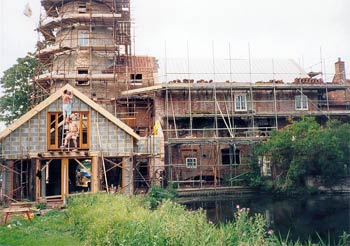 |
Renovation of the complex 1998 |
|
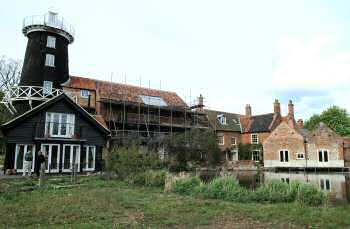 |
|
Mill
dam May 2003
|
 |
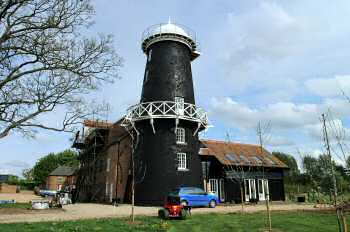 |
|
1977
|
3rd
May 2003 |
| Mr. J. Beck begs to announce that he is favoured with instructions to Sell by Auction on Friday September 30, 1864 all the valuable Live & Dead FARMING STOCK, Miller’s Waggons, Cart etc. the property of the late Mr. Reed. Further particulars will appear in future papers. Norfolk News - 20th & 27th August & 3rd September 1864 |
Burnham Overy |
| Burnham Overy Mills Mr. J. Beck is favoured with instructions to Sell by Auction on Friday September 30, 1864 all the valuable Live & Dead FARMING STOCK, Miller’s Waggons, Carts etc. the property of the late Mr. Reed. … (17th - READ) Particulars of which will described in Catalogues to be obtained at the place of sale, of the Auctioneer & posted free of charge. Sale to commence at 12 o’c precisely. Norfolk News - 10th & 17th September 1864 |
| The Bankruptcy Act 1861 Notice is hereby given that by an Indenture dated 20th June 1866 John Jarrett of Ringstead in the county of Norfolk, Baker, assigned all his Estate & effects to Alfred Lewis of Heacham in the said County, Miller & William Love Porritt of Burnham Westgate in the said County, Miller … for the benefit of the Creditors of the said John Jarrett … in like manner as if he had been adjudged Bankrupt. Alfred Spanton, Solicitor, Hunstanton. Lynn Advertiser - 21st July 1866 |
To Millers |
| Situations Vacant To Millers WANTED, in a Wind & Water Mill, a Young Man as an IMPROVER. Apply to Mr. Porritt, Burnham Overy. Norfolk News - 24th November 1866 |
Wanted in a Wind & Water Mill, a good MILLER (Married) Well recommended. |
| Burnham Overy The FLOUR MILLS, HOUSE & LAND in the occupation of Mr. W.L. Porritt & the DWELLING HOUSES & LAND in the occupation of Rev. G.G. Hayter & Mr. Geo. Tweedy will by Order of the Trustees of the late Mr. Thos. Beeston’s Will, be offered for Sale by Auction in the month of July next. Partridge & Edwards, Kings Lynn. 26 May 1870. Lynn Advertiser - 28th May, 4th & 11th June & Norfolk Chronicle 28th May & 4th June 1870 |
Burnham Overy, Sutton & Norton |
| Situations Vacant WANTED, a thoroughly good MILLER. Cottage found. Apply stating age, reference & salary required to W. L. Porritt, Burnham Overy. Norfolk News - 2nd December 1871 |
Situations Vacant |
WANTED, a MILLER (Married), cottage found. |
Situations Vacant |
Wanted at Michaelmas, a good Miller. Also a Carter for Mill van. |
Wanted, a good General Miller especially as flour dresser. |
Situations Vacant |
WANTED, a Miller as foreman. Trustworthy &: well recommended, without family preferred. House found. |
Wanted for a Miller’s Van, a steady man well recommended. |
WANTED Carter for mill van. Married man who can read & write. |
WANTED as Foreman & Manager in Wind & Water Mills & to help in keeping accounts. If with knowledge of merchandising & malting preferred.Apply stating age, wages required, if with family & references to Mr. W. L. Porritt, Burnham Overy, Lynn. |
WANTED, thorough good general Miller who well understands new processes. |
WANTED by a Miller & Merchant for office work, soliciting orders & making himself generally useful, a sharp active man well recommended. House found. Apply stating wages (moderate) & references to Mr. W. L. Porritt, Burnham Overy. |
IRELANDS |
ROLLER MILL – |
DEATH OF MR. W. L. PORRITT |
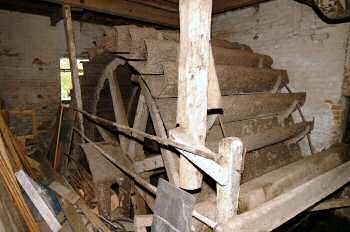 |
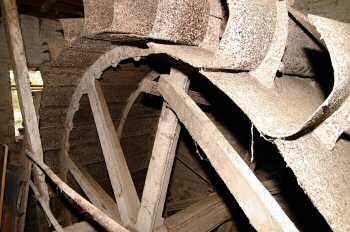 |
||
|
The
iron wheel 3rd May 2003
|
Detail
of the wheel buckets
|
||
|
William Love Porrit was one of the two assignees appointed to administer the estate of John Jarrett, a baker of Ringstead under a Deed of Assignment made for the benefit of Jarrett's creditors in June 1866. |
|
BURNHAM OVERY, SUTTON & NORTON |
To be Sold by Auction by Messrs. CRUSO & HAWKINS at the Hoste Arms Inn, Burnham Market on Wednesday 13 July 1870 at 3 for 4 o'clock by Order of the Trustee of the Will of the late Mr. Thomas Beeston in the following or other lots as may be determined at the Auction. Lot 1. An excellent Double MESSUAGE or DWELLING HOUSE and PREMISES situate at Burnham Overy, Norfolk with the Plantation, Shrubbery, Gardens, Yards, Barns, Coach-house, Stables, Offices and convenient Farm Buildings belonging thereto and all that Brick TOWER WINDMILL and Brick built WATERMILL, adjoining thereto and for many years past occupied therewith, with the Going Gear, Fixtures and Appurtenances; and also several pieces of Land... the whole containing together by Tithe Survey 53a. 2r. 5p. more or less... This Lot and Lot 2 (30 perches of land at Burnham Sutton) are in the occupation of Mr. W. L. Porrit as yearly tenant. Rent £225. Norfolk Chronicle - 18th June 1870 |
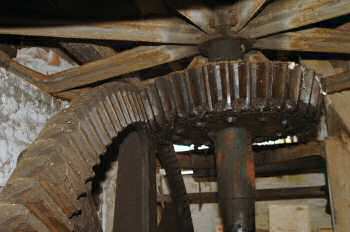 |
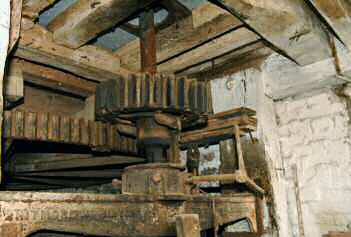 |
|
The
pit wheel, wallower and spur wheel above
|
Stone
nut out of mesh from the spur wheel |
|
For Sale, iron mill shafts, backs, clamps, sails and
everything complete, windlass with suitable gearing and tackle, 3 pairs
of capital French burr mill stones 4 ft. and 2 pairs ditto 3ft. 6ins.
one pair very close for middlings, all driving with the sun, a 'HUNTERS'
Purifier' and 2 long silks. |
 |
 |
|
Belt
driven seed crusher 3rd May 2003
|
The
sackhoist |
|
DEATH OF MR. W. L. PORRIT. |
...at his residence on Tuesday evening of Mr. William
Love Porrit...age of 86... ... carried on a successfiul business as a miller and merchant for about 40 years, retiring in 1900. He was also a most successful farmer, having farmed the Crow Hall Farm for a number of years and in his earlier years resided there. Leaving there about the year 1870 he came to Overy and resided at the Mill House until the time of his retirement. He was the son of the late Mr. David Porrit, maltster and merchant at Burnham Sutton... Dereham & Fakenham Times - 21st September 1912 |
|
When David Barrows purchased the watermill in October 2001, it had been placed on the buildings in danger list and was in a derelict condition. There was no substantial roof etc. However, all the machinery had been left as when it was working in the 1950s. |
|
My great grandfather, also Philip Roy, my grandfather, also Philip Roy, my great uncle Sydney Roy and my uncle Robert Roy all lived in and worked the mill. As a child, I thought that the mill belonged to me because the glass addition on the front proclaimed "Philip Roy and Sons Ltd"! I was born during the war. My father, Richard Roy, had lived and worked at the mill before the war, but then started his own market garden in Burnham in 1938. As a child in the late forties I can remember the shire horses being kept in the stables on the left of the main drive. The top half of the stable doors were always open so that the horses could look out when not working. I remember seeing all their oiled ploughing harnesses on the walls, and being allowed to saunter behind them as they walked to the field that they would be working. A blacksmith/ farrier worked on site named Wilfred Ives.The blacksmith's shop was round the corner from the stables, separated from them by the farm office on the rounded corner. I used to help pump up the forge and hand Wilfred his irons if he was in a good mood. If not, best keep away! I can still smell the odour of burnt hoof and quenched iron that emanated from there! On the other side of the courtyard and behind the cottage was the carpenter's shop, which was run by Jimmy Pike. He was a tall, taciturn man, with no time for youngsters, so I only went in the carpenter's shop when with my grandfather. Although he owned the place, my grandfather was keen to allow every man to control his little "empire". He liked Jimmy because, as a carpenter also, my grandfather recognised his high ability. He once showed me a gate that Jimmy had made, entirely by hand, and told me that "there was not a finer gate in all Burnham!". The mill and its equipment was overseen by Archie Atkins, who was helped by other hands at busy times. Archie was a genial character with a peculiar high-pitched voice. He knew the mill and its machinery inside out. He would sometimes allow me to start the waterwheel moving- there was a large handled brake on the wall-, and he had to lift me up so that I could reach it. The rumbling sound of that wheel as it began to move, and the sight of the water dripping off the huge paddles as they rose into the air was mesmeric. There was a system of belts that drove the mill stones and also, curiously, my grandfather's circular saw outside. I think, probably, that the health and safety executive would today condemn the whole arrangement, but it really was remarkably efficient. There were many other men who worked at the mill, lorry drivers, mechanics and labourers; it was really an industrial village. The farm secretary, Frank Holland, worked in the corner office with a female secretary, and it was his niece that I eventually married! In later years, sadly, the embargo on private milling meant that the mill became merely a barn for the mill farm, and as the skilled men retired from their individual jobs, they were not replaced. From the late fifties the mill was used just for rearing pigs, garaging farm machinery, and housing the grain drier. I did not go there as much then; it had lost its busyness and vitality. (Though I continued to poach trout from the river when my uncle was not about....) I wonder if there is still a message preserved on the rafters which
my brother and I found once, which says "French fleet seen, 1798".
It is written in lead pencil in the roof rafters near the tower, but not
in the tower. I always imagined that some millhand was working in the
mill one day and, seeing the sails passing far out to sea, recorded the
event on the woodwork for posterity! |
It was a real pleasure to read about the history of Burnham Overy Union Mill and the recollections of life in and around the Mill on the website. I will continue to follow the website with great interest and hope this missive provides another view of this wonderful Mill and its surroundings.
Carol Williams - 30th April 2006 |
 |
 |
|
Tailrace June 1968 |
June 1968 |
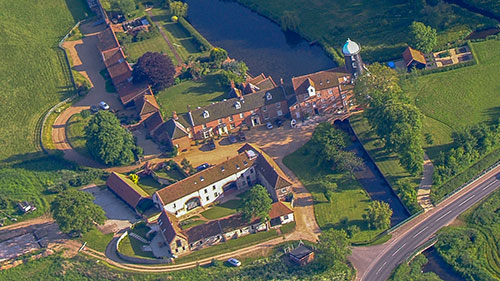 |
|
3rd June 2006 |
|
The watermill was renovated and restored by David Barrows between October 2001 and October 2009. Renovations included stone dressing and repairs to the mill furniture and all the machinery by Millwrights, R. Thomson and Sons. Total repairs to the wheel and buckets by Wensum Engineering included the installation of new sluice gates. |
Burnham Overy Union Mills for sale |
Summary A Grade II listed Georgian watermill with enchanting and quintessentially English views over the mill-pond.Description The Watermill forms part of a range of most attractive Georgian Mill buildings in a stunning setting overlooking the mill-race and mill-pond yet within a mile of Burnham Market's village centre. The current owners oversaw the restoration of The Watermill following its purchase in 2001. Their aim was to create a spacious, comfortable family home whilst also preserving the building's heritage. Original and complementary materials have been used wherever possible; linseed paints, lime wash, pitch pine and York stone are all in evidence and the waterwheel has been fully restored. The workmanship was highly commended by the UK Federation of Master Builders upon completion. HISTORICAL NOTE: The Mill at Burnham Overy Town was constructed c. 1737 on the River Burn and was notable as one of only two mills in Norfolk to be powered by both wind and water from the same site. Called the Union Mill as a result of this, the Mill remained in use for over 200 years adding an engine in the 20th century (as was common practice) to complement the wheel and the sails. ACCOMMODATION: The accommodation is arranged over four floors and capitalises on The Watermill's charming setting above the mill-stream. The ground floor provides a well-appointed kitchen with an electric AGA and a dining room looking across the mill-pond, along with a wet room, cloakroom and mill-room in which the waterwheel is located. The first floor provides two generous reception rooms, each with windows overlooking the water on two sides. The second floor consists of three bedroom suites whilst a fourth bedroom and a further substantial reception room with a partially-glazed roof section are found on the top floor. The dining room opens to a good-sized hardwood deck with glorious views across the mill-pond. Situated to the east of the mill buildings there is a further area of garden planted with saplings in which an old railway carriage stands, now restored to use as a summerhouse. The garden amounts to 0.6 acre (S.T.S.). Adjoining the garden is a Garage Block providing three secure bays with floored storage above one along with a log store. Mill Farm is a small community which consists of twelve separate residential dwellings who jointly own a further 4.75 acres of amenity land consisting of water meadows and woodland. A nominal annual charge is levied by a Management Company for the upkeep of the shared land. Bedfords Sale Details - August 2015 |
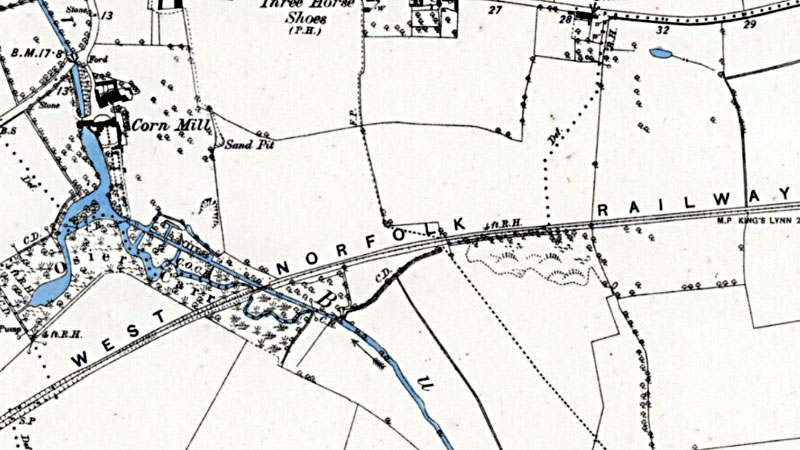 |
O. S. Map 1886 |
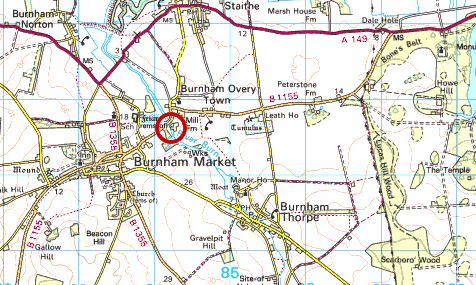 |
O.S. Map 2005 Image reproduced under licence from Ordnance Survey |
1737: Mill built along with reconstructed watermill. Date on watermill
White's 1845: James Read, corn miller
White's 1854: James Read, corn miller & farmer |
If you have any memories, anecdotes or photos please let us know and we may be able to use them to update the site. By all means telephone 07836 675369 or
|
| Nat Grid Ref TF 84234262 | Copyright © Jonathan Neville 2004 |